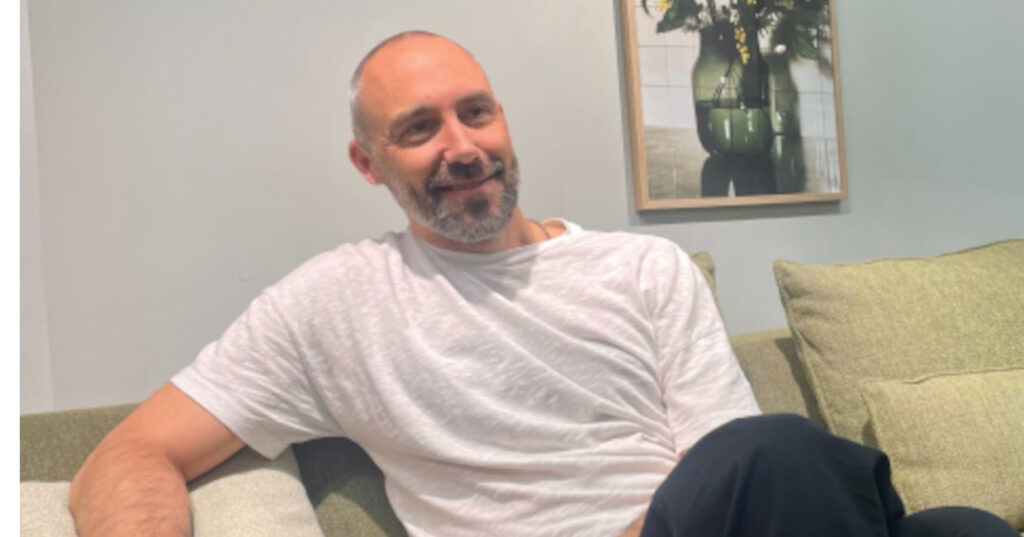As a studio specialising in branding and interiors for hospitality spaces, WeWantMore are pushing the design boundaries. Vicky Doe met with co-founder Ruud Belmans to find out why sustainability has become such a fundamental element of their work and the tool being created to support the wider industry.
Clerkenwell Design Week has a reputation for facilitating unexpected moments and chance meetings, and this year’s event gifted me the opportunity to meet an inspirational designer! Ruud Belmans is Creative Director at WeWantMore, the studio he created 18 years ago, and his passion for truthful and authentic sustainable design is infectious.
The studio has spent almost two decades focusing their work on branding and interior design, which Ruud says are more related than one might think: “They use the same design principles like composition and contrast, it’s just the medium that is different. The tools are different but the messaging is the same- the focus is always on the brand. Whatever you design and create, it all goes back to talking about that same brand.”
Growing continuously, year-on-year, the studio has chosen to primarily focus on hospitality with some of the big names in the industry choosing to use Ruud’s team –Hilton, IHG, Accor and Marriott to name a few. Smaller, independent brands are also utilising the studio’s skills, as are large retail brands, such as Heineken International.
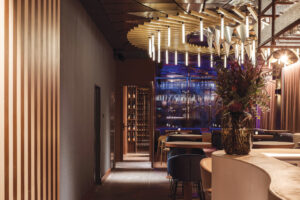
The team’s skills were put to good use at AUM Restaurant and Bar in Brussels where the branding and interior design teams worked together to create a space that celebrates warmth, light and detail. The interiors within the venue develop as the night progresses, with the soothing dining experience giving way to a ‘bonfire club’ where window shutters made from wooden beads glow during the evening.
Another Belgian project, CRAFT, allowed the team to flex their branding and interior design skills with bespoke furniture and lighting concepts alongside the use of natural and raw materials to create a distinct atmosphere where a range of seating options provide a dynamic space.
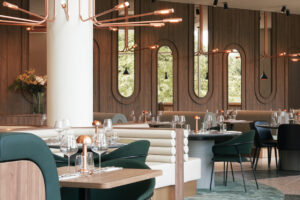
But sustainable design is of the highest priority for the studio. Ruud explained that this interest was piqued around four years ago. He explained: “We had all been talking about sustainability for a while but we did not really see a lot happening, especially in the interior design industry. In 2020, just before the pandemic, I realised that we were being quite hypocritical, because we were talking about it like everyone else, but we did not really change anything. So, I started to look into the reason nothing was changing, and it came down to the fact that it’s not because of bad intentions or lack of interest – it was just too complicated!”
Ruud recognised the need for clarity across the industry when it comes to making sustainable choices and ensuring that designers and stakeholders can make decisions that meet the needs of their clients, as well as their own targets. He explained: “The data that designers receive from suppliers is so diverse you can’t compare it – it’s a jungle! So we decided to turn that around, we felt that designers need a tool to manage sustainability throughout their entire process.”
He compared the tool to a costing budget: “When a designer gets a project, he knows what the target cost is and every purchase feeds into that. I wanted to apply the same logic to sustainability – when choosing flooring, for example, the designers need a number that indicates how sustainable the flooring is and if that fits into their sustainability budget.
“So that is what we are creating – a tool that can translate that information and allow designers to made the best choice for their client and targets. But behind that you need a lot of data. In 2021 we developed the tool in house for ourselves and pulled it all together in a huge spreadsheet which generated a score.”
Having shared the tool with clients, Ruud and his team have discovered a great deal of interest in the software, and they have received requests asking them to develop the tool further so other studios can use it and it can become something of an industry standard. Ruud said: “That’s what we are doing now – we’re developing a standalone tool. We are hoping the first version will be ready in September/October. We’re talking to a couple of other design studios to do some further testing first and we’re talking to some of the large hotel brands to get opinions from their side – they also need to understand the system so they can brief studios on its use.”
Ruud explained that although other tools are available, the don’t go far enough in terms of interior design: “There are lots of bespoke elements within hospitality design that other tools just cannot cater for in terms of measuring the sustainability of a product. We need this standard so that the industry can make comparisons, and real targets can be set and met.”
So is this becoming a new ‘arm’ of WeWantMore? Ruud explained that the team are looking into revenue streams but his personal mission goes beyond that of a commercial enterprise – he wants this tool to be available to designers so that real change can happen across the industry and real differences can be seen and felt: “If we just keep it for ourselves, and some selected studios are able to afford it, then we’re not creating impact at all. Almost every studio needs to be able to use it, because otherwise, there’s no point to it. This is about really having an impact.”
And whilst all of this exciting development goes on, Ruud is still running the WeWantMore studio – with projects ongoing, including a Movenpick Hotel project in Brussels inspired by surrealism. The team have created the interiors for the entire hotel – the guestrooms, restaurant, lobby, and the gym – with different members in the team taking on the different spaces. With other projects in Amsterdam and Rotterdam as well as new ones on the cards in the US, there is no stopping this team!
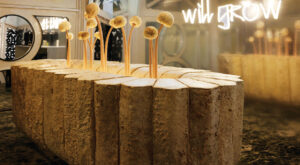
We discussed other projects that the team are proud of – Ruud shared how he has worked with fast food chain McDonald’s on their sustainability objectives – by creating an easy-to-dismantle design with the goal of recycling or reusing items- and we reflected on the team’s work at Hix in 2022, where they designed a Mush Room Bar. Ruud said: “The idea behind it was pretty cool, because the bar would only be there for two days. The theme of the show was ‘great things will grow’ after the pandemic and so we decided to design this bar feature with the theme in mind. It was a huge piece and everybody really loved it, they still talk about it. After those two days, it moved to the Royal Botanical Gardens and it’s still there, it’s decayed because it’s outside and it’s going back to nature.” A fully sustainable project to be proud of!
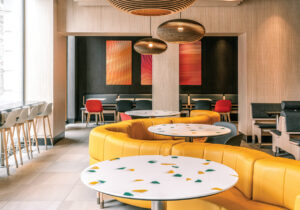
Ruud concluded: “Our work just about inspiring people to think and act differently. Inspiring people is great but I’m really happy that we can also create tangible impact on a bigger scale.”


